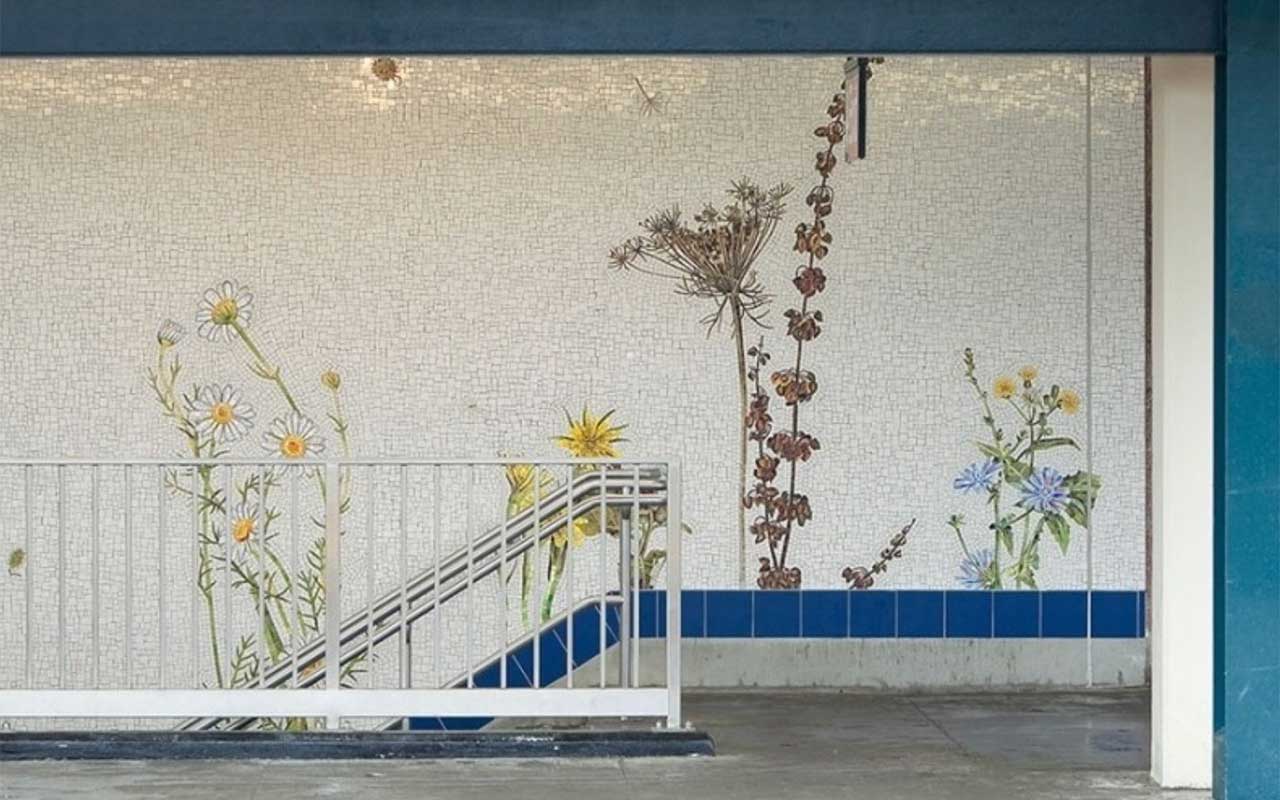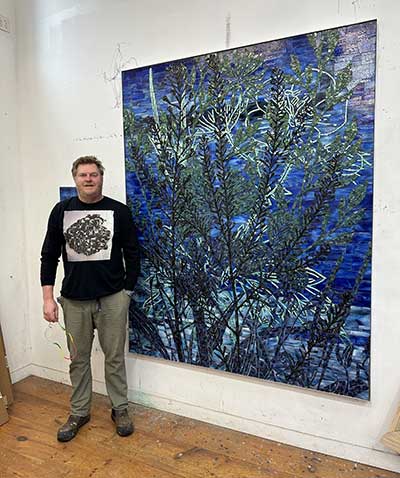Featured Artist

For Jason Middlebrook, Nature Always Prevails
I first learned about the artist Jason Middlebrook while assisting Deborah Goodman Davis, an art advisor based in Lakeville, CT, and New York City, with a show she curated for James Barron Art in Kent, CT. The show, currently on view until March 11 is titled Mosaics, and it brings together a body of work by “artists who express themselves in different styles and media, while hailing from different countries and generations.” Throughout her many discussions with James Barron deciding which artists to put in the show, Ms. Davis was consistently resolute that local Hudson, NY artist, Jason Middlebrook, be included. Not only because of his skill with the traditionally associated artwork of mosaic, but also perhaps because his body of work itself, is in its own way a mosaic of mediums.
Conceptually promiscuous
Middlebrook is an artist who gathers creative inspiration from both nature and technology and transfers their complex relationships into works of sculpture, installation, paintings, mosaics, and large scale drawings. He says that his practice has sometimes been described as “schizophrenic” and “conceptually promiscuous.” However, there is continuity and major threads that intersect one another throughout his work. No matter the creative medium, interconnection between human beings and nature is always apparent. His work is often a reminder of human beings’ wastefulness and how modern living can be destructive to the planet. Yet Middlebrook remains optimistic about the resounding strength of nature and the complex, inspiring force behind it that no human being can truly understand.
Middlebrook says, “All the things that people are upset about are essentially human conditions. I don’t want to go down that road to be inspired by those things because I find that the more energy we give them, the more power they have. I want to be inspired by nature. Nature for me is far more complex than human problems. Not to discredit human problems but the theme of my work is that nature is the guiding force behind it and the ultimate force behind that is that we don’t truly understand nature and we are all kind of afraid of it.”
Environmental accountability
Middlebrook is fascinated with the ways nature erodes and changes man-made objects over time and utilizes those objects as an opportunity to illuminate the need for environmental accountability. He will often use recyclables and discarded materials as his medium such as a sculpture made from hundreds of plastic bottles or a cascading waterfall mobile made out of Styrofoam. In 2009, Middlebrook exhibited Live with Less at the University at Albany Art Museum showcasing a 35-foot tower made from two tons of cardboard collected on campus over a one month period. The tower, analogous to a landfill, brings awareness to human consumption and begs the question: can we live with less?
In 2010, the Museum of Contemporary Art Chicago invited Middlebrook to participate in a show responding to the work of Alexander Calder. He began collecting objects, primarily wood, that had gone through some kind of life in Chicago and then been dumped on the streets – three-legged chairs, mantles, window sashes, lattice, spindles from the electric company, and even cribs. He put them all together in a sculptural mobile, counterbalanced by a massive log. It was, in essence, a project about the history of these objects, how they are discarded, where they come from, and asked the question: at what point do we get tired of the things that we live with and need something else? Again, Middlebrook brings awareness to human consumption and waste. What really happens to objects when they are thrown “away”?
Metaphors
Middlebrook’s MTA installation Brooklyn Seeds is a massive glass mosaic garden of native weeds and wildflowers including milkweed, burdock, goldenrod, aster, daisies, and spotted knapweed that grow in unexpected places like cracks in sidewalks, on the outside of buildings and in alleys. The seed pods floating in the air and moving in various directions can be thought of as a metaphor for the subway traveler moving around the city. The installation takes a look at the way human beings and nature interact and how, despite mankind’s best attempts to contain it, nature always breaks through and prevails.
Creating in the Hudson Valley
 In 2005, Middlebrook relocated with his family to the Hudson Valley where he began working with indigenous hardwoods purchased from a mill in western Massachusetts. His inspiration for the work came from his love of minimalist artists like John McCracken, Frank Stella, Ellsworth Kelly, and Agnes Martin. He paints on textured, sliced planks of timber attempting to superimpose his own grid on top of the beautiful wood grain. Out of respect for the natural magnificence of the wood, Middlebrook describes himself as a “visitor” and stays on the surface, creating a symbiosis between the paint and the organic form of the wood. The idea is analogous to the ways mankind is trying to put a skin over the earth with sidewalk and asphalt, yet that “skin” is constantly being broken up by weeds, tree roots and erosion.
In 2005, Middlebrook relocated with his family to the Hudson Valley where he began working with indigenous hardwoods purchased from a mill in western Massachusetts. His inspiration for the work came from his love of minimalist artists like John McCracken, Frank Stella, Ellsworth Kelly, and Agnes Martin. He paints on textured, sliced planks of timber attempting to superimpose his own grid on top of the beautiful wood grain. Out of respect for the natural magnificence of the wood, Middlebrook describes himself as a “visitor” and stays on the surface, creating a symbiosis between the paint and the organic form of the wood. The idea is analogous to the ways mankind is trying to put a skin over the earth with sidewalk and asphalt, yet that “skin” is constantly being broken up by weeds, tree roots and erosion.
For the Mosaics show, Ms. Davis chose one of Middlebrook’s sculptures that builds upon the natural canvas of a tree trunk to construct a whimsical geometric composition. The tree trunk is tiled in a ceramic and stained glass mosaic and as the light changes over the course of the day, so does the reflection off the tiles. Middlebrook’s lighthearted yet reflective investigation between man-made objects and nature is on full majestic display.
Interview with the artist
What drew you to the Hudson Valley?
I had been living in Brooklyn, Williamsburg specifically, and was looking for more space for my studio. I came to visit a friend in Hudson for the weekend and fell in love with the place – it was a blast from the past, and only a hundred miles from New York City.
The city is great but you are one fish in a big pond of so many other artists who are all competing for the same thing. It’s driven by greed, it’s dirty, it’s just not a healthy environment and I didn’t want to raise a family there.
When you’re younger it’s glamorous – you run into Frank Stella and Ellsworth Kelly on the street, and you’re out all night. But, you’re just a number there, and in the country the relationships are much more personal. And once I got out of the city I realized there were so many other opportunities elsewhere and that’s when my career really took off.
How has living in the Hudson Valley affected your work as an artist?
The theme of my work in the city was more about nature’s battle with humanity and how the evolution of the city was always threatened by nature – that’s where you get the images of the weeds busting through the concrete, it was this perpetual tension between nature and man constantly trying to contain it. When I moved here, it became more about my craft and less environmentally conceptual. It became a delicate dance with nature rather than the fight for it like it is in the city. I thought about how I could represent nature through my eyes with different materials, in an eloquent way. When you start to spend a lot of time in nature you become in tune with it, whereas in the city it is always a battle just to get a small piece of it.
Where does your desire to use art as a vehicle for environmental responsibility come from?
It starts with growing up in California and from my mom who is a radical plant designer and native plant advocate, she instilled an awareness in me from a young age. Living in the Hudson Valley, climate change, and particularly from raising a family, I started to think about how we could tread more lightly. It’s our responsibility to leave the Earth as if we were never here, and not take the Earth for granted.
I used to think I should be more heavy handed about it, but it doesn’t have to be so political, I just want people to pause and be in the present and have an experience with the art. Perhaps it will encourage people to think about things more carefully before making decisions about our resources.
What’s next for you?
I’m really excited about the next body of work in terms of my mosaic paintings in particular because I’ve already done so much on wood with the plank series. It’s almost impossible to create something new – all art is essentially derivative, but when people see my art I want them to say, “I’ve never seen anything like it.” I want it to have an indelible mark on their memory. The goal is to do something that no one has ever seen before, and I don’t think I can do it with painting or sculpture but I think I can with my mosaics.
To learn more about Jason Middlebrook and his work, you can visit his website at www.jasonmiddlebrook.com. The show “Mosaics” is currently on view at James Barron Art in Kent, CT, until March 11.

